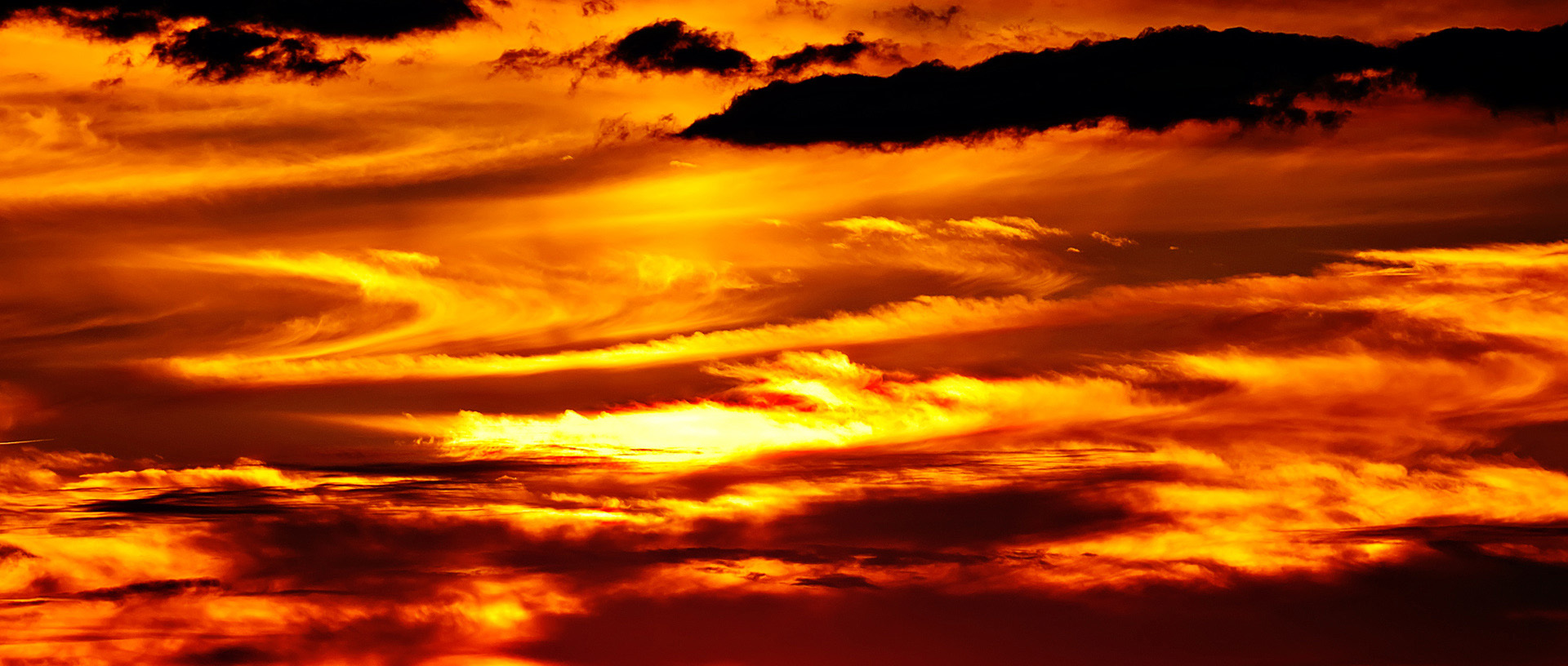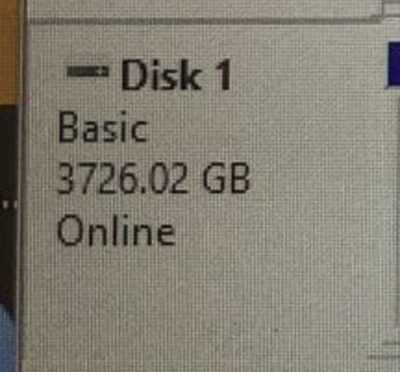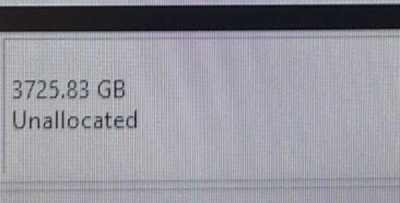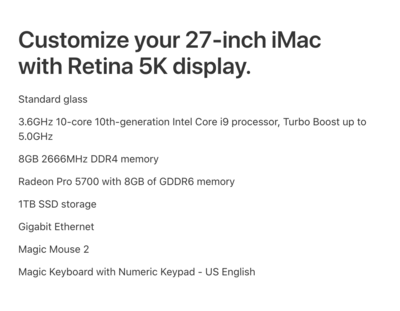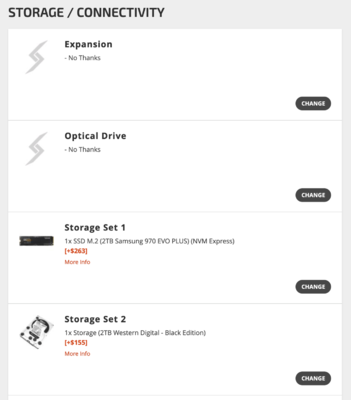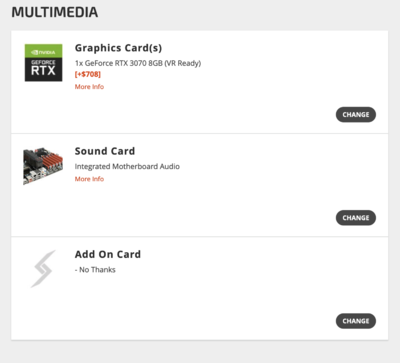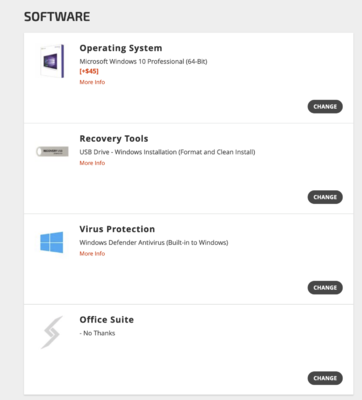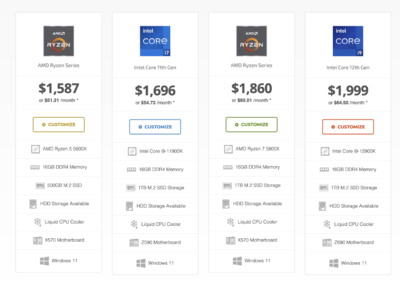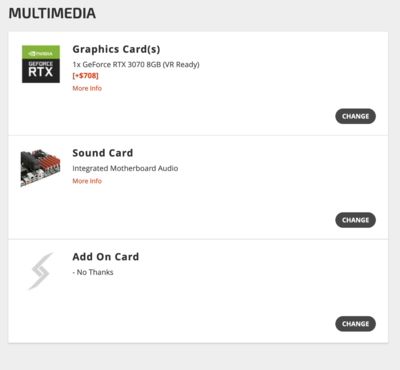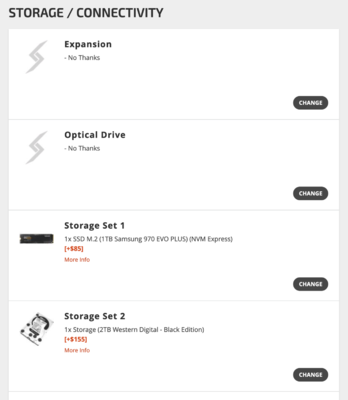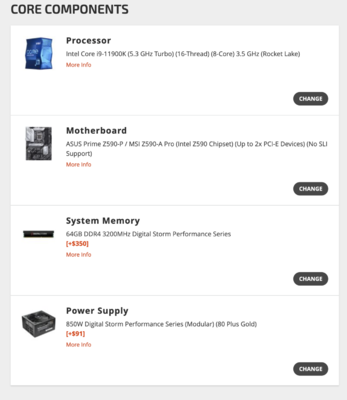-
Posts
4,103 -
Joined
-
Last visited
-
Days Won
52
Everything posted by Brian
-
That's marketing. Hard Drive Manufacturers say that 1000GB is 1TB. Microsoft says 1024GB is 1TB. You will ALWAYS LOSE capacity when you partition/format. 3815GB is 4TB after being formatted. Surprise!!
-
PHEW!!! That's MUCH better. OK, delete the 200MB Partition? I want to see nothing but a black bar all the way across. If you can't that's fine. Then I want you to Right Click Here: Look for "Convert to GPT Disk." But I'm thinking it will say, "Convert to MBR." IF it says "MBR," don't do anything, because it's already a GPT Disk, and then right click in this area and select "New Simple Volume" Then follow STEP 9 and beyond above. ^^^^^
-
Damien is correct, iMacs from 2015 to current, use GB-LED for your Display Technology Type.
-
The only drive that is listed is your current internal one. Where is the new External Drive? I thought you purchased a new 4TB External HD and that it arrived. Correct? Connect the new External Sandisk to your computer, power it on if needed, and it should appear in the Disk Management Window. Post a screen-shot and we will continue.
-
STOP!!! YOU ARE ON THE WRONG BLASTED HARD DRIVE!!! You are not following my directions!!! Where is the new 4TB Drive? It's not in the list!!!! You are about to Royally Screw Up your computer!!!! You don't go from 2TB to 4TB, you select a new hard drive. You can not make a 4TB Drive out of an existing 2TB Drive.
-
I need a screenshot of your Disk Utilities Window. All of the partitions on the new drive need to be gone. Right-click on the existing partitions and select delete. We need the drive to be completely blank.
-
OK! Let's get that external powered up, don't hook up the USB Cable right now. Speaking of USB, for the best performance, be sure to utilize a USB 3.0 Port. Deleting a Windows Partition and creating a new one is pretty straightforward, and just takes a few minutes to complete. No special software is needed, especially software from the Hard Drive Manufactures; all that is required is built into the Windows Operating System so do not use ANY Manufacture's software, it just gets in the way. So let's begin! Right-Click on the Start Button and select Disk Management: This will bring up the main Disk Management Utility Window. Make note of which hard drives are currently mounted. Most folks will only see one HD, labeled Disk 0: Now insert the EHD into your USB port and allow it to mount/spin up. It should appear in the list. In this example, note "Disk 1" that appeared in the list after it mounted. This will be the drive that I will modifying; your Disk Number might be different so pay attention and be sure to select the correct drive. There is no difference, it's just another number in the list. It could be listed as "Disk 3" or even "Disk 5," Again...THE IMPORTANT THING IS THAT WE CHOOSE THE CORRECT DRIVE! This is why we hold off hooking up things until now. I want you to pay attention to WHAT drive your new EHD is, so you don't screw up and delete the wrong drive! That would be bad. Select the Partition that you would like to Delete. The box will go from a plain white background to one that has slashes in it and should be highlighted. This is Windows' way of letting you know which Partition you have chosen: Now Right-Click on that Partition and select Delete Volume. It should go without saying, that you really-really-really want to be sure that this is the correct Partition to delete. A Warning Message will appear asking for permission to delete. If the Partition was created on another type of OS, such as a Mac, this error message will appear differently. This is completely normal, just click "Yes" and wait a few seconds. Error Warning with a Windows-Created Partition: Error Warning with a Macintosh-Created Partition: After deleting your Disk Management Window should have your (new) EHD as a large, solid/continuous black line: At this point, if your HD is 2TB or smaller, we can continue with the Wizard to create a new Partition. If your EHD is 3TB or Larger, then we will need to covert the Drive from a MBR Disk to a GPT Disk. This step ONLY affects those with EHDs that are 3TB or larger. GPT is meant to create a single partition that is larger than 3TB since MBR has a 2TB maximum limit. Make sense? To convert it to a GPT Disk, right click on the Disk # Box in the left column you are modifying and select "Convert to GPT Disk" and follow the prompts. (Click OK, OK, etc., etc.) Note: I do not have a 3TB Drive hooked up for this document, and am using this next example as a guide. Your 3TB HD will be larger in capacity than my smaller one that I'm using in this tutorial. The important thing is to right-click on the Drive # box that you want to convert to a GPT Disk: After Right-Clicking on the Drive # square in the left column, select "Convert to GPT Disk" and follow the prompts. Again, this is only for the folks who have 3TB or larger Hard Drives! 2TB or smaller, leave it at a MBR Disk. Now for the fun part, creating a new Partition! Right click on the area that has a black stripe and select, "New Simple Volume." The Wizard should appear, click Next: Specify the Volume Size. For the majority and this example, we will leave it at the default, which is the maximum capacity of the drive. If you are going to create multiple partitions on this Hard Drive at different sizes, I'd use an online calculator tool to create the size you need. For example, if you wanted to create a 6TB partition, you would enter 6,291,456. But to keep things simple, leave it at the default and click next. Assign a Drive Letter. This is the spot that you can assign a drive letter if you choose. For example, if this EHD is one that will contain personal files. we could change the Drive Letter to P:\ for "Personal Drive." Again, this is completely up to you to decide. There is no right or wrong answer. If you'd like all of your EHDs to be the "E Drive" (i.e. E:\ ) then change the default to E by clicking the Down Arrow next to the Drive Letter and selecting E. Please note, that if you use an external DVD Drive, or another drive that uses the same drive letter, things might go wonky for you if you hook up both devices at the same time. So don't be afraid to "spread" things out. Drive Letters A --> E are the most traditional, so anything that is "H" or above is almost always fair-game. After making your choice, click Next. We will leave it at "D" for this example. The next screen is very important. It's the "Format Partition" selections. For today's modern Windows Computers' hard drives that are meant for permanent storage, you want to use NTFS. Some devices like Thumb Drives, you would want to use FAT32. Again, for this example we will leave it at the default of NTFS. The Allocation Size should be left at the default and it is highly recommended that you give your HD a name, to keep things organized. "Data," "Photos," "EHD #2," etc. are all examples. Keep is short and simple. Before clicking Next, be sure to click the check-box next to "Perform a quick format!" Otherwise it will take HOURS to format your HD! Leave the "Enable file and folder compression" UN-CHECKED. Click Next. A Summary Window should appear with your selections. Confirm them if you'd like and click Finish. The Hard Drive will begin the process and Windows will assign it a letter and name. This process should take less than 30 seconds, but this depends on the speed of your computer and Hard Drive. Some complete this task in as little as 5-7 seconds, others take longer. When completed, the Disk Manger should have the drive in the list, along with the name that you chose for the drive: Exit out of the Disk Manger and either use "This PC" or the "Windows Explorer" to use the new Drive. With any new Hard Drive, now is the time to think of a Directory Structure on how you want to organize your Hard Drive. This is completely up to you, but I would take the time and think of how you are going to store stuff, rather than it become a dumping ground for your files/images. Here is one example: You could also keep things very simple, and have folders that are just the year: The sky's the limit! So make your Directory Structure a good one!
-
Keep in mind: They are ALL CRAP. Anything that is man-made can fail. In reality, you are picking the lesser out of all the Evils. With that in mind, here is what I tend to avoid: ANY HD that is $99 or $79 from a Big Box Store. ANY HD that is "Eco Friendly or Green" - These are the drives that I really avoid like the plague. They are often cheap and have very nice buzzwords about being good for the planet because they consume less power...blah-blah-blah. Let's all sing Cum-Ba-Ya Children!! We are protecting Mother Earth!! BULLSHIT. These type of drives DIE ALL THE TIME. So what happens then? They end up in Landfills, so any "Green" thing that made you feel better when purchasing this crap gets tossed out the Window. The only difference between a working Green / Eco-Friendly Drive and a dead one is about 3 weeks. Seriously. E-Waste is a very real thing, and since China has stopped taking all of our crap, you'd be surprised on just how much our "recyclables" end up in Landfills. Don't even get me started on plastic water bottles and plastic shopping bags. But it's all about feelings, right? But I'm digressing. Anyway... I also tend to avoid 5400 RPM Drives as well. For traditional HDs, I like mine being 7200RPM. Yes, there is a difference in speed read/write times between a 7200RPM Drive and a 5400RPM Drive, and those Eco Drives that I'm bitching about are usually the 5400RPM variety. How do you know what do you have? The easiest way, though not 100% is if your EHD has a separate AC Cable that connects to the drive, then it usually is a 7200RPM type. 5400RPM models just have the USB connection and that's it. USB will support a 5400RPM Drive but the 7200RPM Models need a little more "Umph" and require their own power source. For me personally, I avoid Seagate HDs, I've had too many fail on me over the years. Normally, I prefer Western Digital Drives, but only a certain kind. The Western Digital Black Drives. Honestly? It is really tough for me to recommend a typical EHD that's an "affordable" model. People are not used to spending $500 or more on a EHD. Heck, the one I linked to above is $850! So this is where I pay attention to the reviews. If a particular drive has lots of positive reviews, and I really do go over the reviews, ESPECIALLY the negative ones, to weed out things. When reading reviews, you need to keep this in mind: Everything is awesome when it works, but what happens when it breaks? How is Customer Service and Turn-Around Times for Warranty Claims? Also, it's important to have multiple copies of your HDs and have them stored off-site. This way if something very bad were to happen, you are just inconvenienced and not in a full-blown panic. It happens more often than it should; people have everything on one EHD and then it dies or gets knocked off a desk and then they realize the weight of the situation. A HD Failure should be an minor irritation and a time-suck of a few hours, not spent begging for help in forums or using software to recover any possible files. Or at the very worst, forking out $1500-$2000+ for a Data Recovery Service to perform their Voodoo Chants and do major surgery to get your data back, if they can at all.
-
I like and own G-Drives. Here is the latest version of what I have: G-Drive 18TB Thunderbolt 3 I will warn you, these are Enterprise-Grade Beefy External Hard Drives that are not cheap. I have a 12TB capacity myself.
-
This is where Damien’s and my opinion differs. I also primarily work off and external drive, but I do not use a standard USB EHD, my EHD is a fancy Enterprise Grade HD connected via a Thunderbolt 3 port, which is extremely fast. My TB3 G-Drive feels just like I’m working off an internal, though my internal SSD is much faster regardless. If all I had was USB 3.0 to work with, I’d copy my projects / sessions to the main drive, work on them, and then move the files & images to a EHD. Some of our members are forced to work off an external, due to them only having a laptop with a Microscopic Internal HD, usually 250GB or less in total capacity. Those folks have no choice than to work off an external. it’s really a personal preference, but again, if you want to work off an external, make sure you use the fastest port on your computer and please use a high-quality EHD, not one that’s a $79 Special drive from a Big Box Store.
-
Something is wrong with the Hotshoe or the Godox Transmitter you are using is incompatible with your camera body. It could be a something stupid like one of the pins not lining up 100% from the transmitter to the hotshoe. What make/model/brand of camera? Is there any kind of firmware updates for the Godox stuff?
-
Here is the process for taking a 27" iMac from your era apart. If you aren't careful, you could rip the Display Cable out of the Connector on the Motherboard. In which case, you are screwed.
-
It looks good then!! Enjoy your purchase!
-
No, and external HD will not help you in this situation. You need a new INTERNAL Drive. It's that Fusion Drive that's killing you. A SSD Drive will speed things up, but it's just a band-aid. It's also something that you really can't do yourself, because if it's an iMac, you need to take apart the whole damn thing just to get the HD out (you start by removing the screen.) While I understand it's a good way to help things out in the short term, I feel you are going to be right back at square one in a year. Plus, Macs after 2011, the screens are held on by a special glue strip, so you will need an install kit as well as the HD, plus a interface cable that bypasses some sensors on the Apple HD. I think you are just opening up a Can-of-Worms trying to make it something it's not.
-

Hear question concerning megapixels
Brian replied to Michelle Gifford's topic in Photo Gear & Equipment
Yeah, who knows...they might salvage things. Even if it costs say, $600 for the repair, that's a lot less than a few thousand on lenses that won't be in stock anytime soon. If you need that lens to make money and let's face it...you need lots of money, this is a just cost of doing business. Just remember to save the receipt for this years taxes. Hopefully they can fix it and you can put it to good use to get cash. -
Both are fine. Just be sure to get Windows 10 Pro for right now. The reason is, Windows 11 is BUGGY. Personally, I'm waiting until 2025 before I even attempt upgrading to Windows 11. But it sounds like they are selling you a Windows 11 license, with downgrading to the previous version, which is completely fine. When it comes time to upgrade to Windows 11, you will be able to without major issues. How much Video RAM for the Graphics Card? You want at least 8GB in 2021/2022. All I see is this: I'd say you are 99% there. Monitor: For $379, this isn't a bad one: https://www.amazon.com/Dell-Ultra-Thin-FreeSync-DisplayPorts-Certified/dp/B091955LC7/ref=sr_1_12?keywords=dell%2Bultrasharp%2B27%2BIPS%2B2560%2Bx%2B1440&qid=1638934611&sr=8-12&th=1
-
Correct. Because you have this, you are basically stuck with a 24" Display 1920 x 1080. Just make sure it's IPS based and has a HDMI port. Remember, technology-wise, it's 2012 for you. 4K was just beginning in that era. In reality, you need a new computer.
-
Yep. Let me know when it arrives. Partitioning and Formatting takes about 5 minutes and is very easy to do.
-

Hear question concerning megapixels
Brian replied to Michelle Gifford's topic in Photo Gear & Equipment
That's smart. No sense in forking out $4500+ without being 100% sure. Of course, gear that is rented is usually beaten to hell, so keep that in mind. You actually answered your own question. The 60D is a "Pro-sumer" body, just enough features to make you feel important, or "...that's a NICE camera! You must be a Professional Photographer!!!" and they purposely leave enough out to get you to upgrade. See? It's supposed to be that way. The 6D, is a nice sensor mounted in a crap body. Like the Nikon D600/D610 Counter-part, it's a "Bridge" Camera, meaning it's a entry-level full frame. Again, the whole intent is to get you to buy the bigger camera bodies. But forking out $6000+ for the Camera Body that has ALL the features turned on is out of the price-point for the average user. So you end up spending the same amount of money over a period of time with multiple bodies and upgrades vs. if you just bought the Flagship Model to begin with. Either way...you have spent $6000-$7000 over a period of about 5-6 years, right? Not to mention the huge profit with batteries and such; well, if you bought OEM Batteries, etc. That's another reason that I recommend OEM glass. It will last you 20 years if taken care of properly. Well, it used to. Now everything is crap with planned obsolescence built in. New Sensor Technology trumps old. It doesn't have to do with Mirrorless, you are just seeing photos taken with a modern camera sensor and modern processor/ camera body software, that's all. If Mirrorless didn't exist, you'd probably see similar results with a "Canon 5D Mark V." (Or whatever.) -

Is this computer 'good enough'
Brian replied to Lauren emjay's topic in The Windows & PC Hardware Forum
Yes. Any price I list is in US Dollars as we have members from all over the world and it's just easier for me. That, and I'm too lazy to Google to do the currency translation. NOPE. You are editing Photos, not editing Video. As long as it's a 27" iMac from 2017 or newer, and has a Video Card with at least 8GB of Video Memory, that other Mac should be fine. If it's used, MAKE SURE IT'S NOT LISTED WITH THAT PERSON'S ICLOUD ACCOUNT!! -

Hear question concerning megapixels
Brian replied to Michelle Gifford's topic in Photo Gear & Equipment
OK. You have very valid points in upgrading. I wasn't trying to be a meanie or a Jerk, But you'd be surprised how many people try to buy their way out of things. Now that I know the situation, it gives me more to work with. Yes you do. This time, I want you to buy a Canon Canon RF 70-200 f/2.8L lens. With OEM Glass, there is a difference and I'm a Nikon OEM Snob. You don't realize the difference until you shoot with one on a normal basis. "...But! But! Sigma! Tamron! These MTF Charts are better and this blog-post or YouTube Personality says..." blah-blah-blah!!" Save it. There is a difference in build quality and the consistency of images that OEM Glass produces. Plus the whole resale thing if that ever were to happen. People buy that $1400 Sigma lens, then they go to sell it and only get offered $200 at most. "But I spent $1400!! Can you do any better?" Shop-owner, "...well it's a Sigma, so no. $200 it is. Take it or leave it." Since you make money with your gear, it's important to have things you can count on working and produce better results. It's not a good thing to shoot 300+ images to get 44 "Keepers," and if they are mostly mediocre, it's not worth your time. Time is money. Wasting it to polish "Meh" photos isn't going to work long term. You know this. The big question is, Budget?. How big is it? Because honestly? You need just about everything replaced. Now that you've told me what you are shooting, I can honestly say the R6 is definitely worth buying. Personally, I have a love/hate relationship with my D850. People rave about the D850 but for me, I'd rather have spent the money on something else, or better yet, saved that money. Here is the thing, you are going to need RF glass with a Mirrorless Body. I'd recommend getting a Canon RF 24-70 f/2.8L lens in addition to the R6. Hold off on buying a computer for right now. Prices are insanely high for what you get, and if you can shoot less and yield better results, you can make the most of that right now. Plus, as I've mentioned before, you are going to need RF Glass with a R6, (Man, I sound so repetitive, please bear with me. LOL!) If you think it's better with your current lenses, you haven't seen anything yet. For example, in order to take advantage of the "Sensor-Shift 5-Axis Image Stabilization," you need to use the RF Glass. Otherwise, it's just the 3-Axis Stabilization. The problem is...availability. Stuff is sitting on ships off the cost of California. Many items are on back-order and you need a R6 and new RF 70-200 2.8. I totally get what you mean about the compression. The 70-200 is what you use to create those shots for the Portfolio. I need to use mine more. I'm always using my 24-70 f/2.8, but I shoot Weddings Professionally and it just works better "Running & Gunning." I also have a friend that was forced to purchase a Nikon Z6 body due to a hand issue (She shot with a D4.) She wasn't 100% Happy until she replaced her 24-70 f/2.8 with the 24-70 2.8 Mirrorless version. For now, keep using the 24-105 f/4L for the short term, but budget for the RF 24-70 f/2.8 and sell the 24-105. I'm dead serious. Even though you might not use f/2.8 all the time, it's nice to be able to open up to f/3.2, which is a lot more forgiving than 2.8. Oh, one more thing...give yourself time to fiddle with your new gear. The way you capture images and focus on things is going to be different with a Mirrorless body. So take a solid Weekend or two to fiddle with your new gear. Shoot everything. After a month or so, you will get better. When it comes to editing, you are going to have to change the way you edit. Sigma Glass tends to add a bit of yellow with a lot of their lenses, and Tamrons add red. But you might be used to this by now since you shoot with both Canon and Sigma Glass. But again, you still need to fiddle. In the end, I'm thinking you need to cull your images on your drives with RUTHLESS INTENTION. Meaning you do not need 75 photos of your lunch from 5 years ago. Any photos that will never see the light of day, DELETE-DELETE-DELETE. That should save on storage to get your through. Since the R6 only has 20MP, you can make due with what you have. I know this isn't as fun as buying a new computer, but you need a new camera and 70-200. This will make you money so you can afford to buy a better computer because honestly? It's going to be a year or two before prices stabilize. Inflation is here to stay and the "New Normal" will probably hit in 2023; prices will eventually lower, but won't go back to the ranges we had in year's past. (Translation: a $999 computer won't probably cut it that is "Good for Photo Editing." That price will be in the ballpark of starting at $1500 or so. Furthermore, if you do go to the R5, you are going to be replacing just about everything. Including ALL of your lenses. I have such "Buyer's Remorse" with my D850. I had no idea of what I was getting myself into with 45.7MP. I should have taken the $4200 or so on a SECOND 24-70 & 70-200 on top of the D850, plus larger media cards, and put it towards a Nikon D6. Speaking of D6, I also have a D4s body. I can tell you that if you ever upgrade to the level of a R3, or any other Professional Body for that matter, anything else that is lower end will feel like a shooting with a toy camera. You have been warned. Bottom Line: This Shit can get real expensive really quick, and you are at the point I was 5 years ago. I can tell you from personal experience that it's going to be expensive for the next few years. It's not fun. At all. You need to approach things logically that will yield the most revenue and that starts with a new Camera Body and Lenses. Hold off on a new computer, at least for the short term. If you buy things now, and are a legit-on-the-books Photographer, this will be a Tax Write-Off for this year's taxes. Which hopefully will soften the blow so you can afford to buy more gear next year. Keep me posted on what you decide. An inquiring mind wants to know! -

Is this computer 'good enough'
Brian replied to Lauren emjay's topic in The Windows & PC Hardware Forum
Now I'm going to configure a iMac that I would purchase today. We are starting with the 27" Model and the most expensive one. (Believe me, this is the cheaper route as you are penalized for choosing a lower-priced Mac; meaning the upgrades for things like storage/video cards and such, you pay more since you picked a lower-priced Mac. Sneaky, huh?) Here is the config: Basically, I upgraded the CPU, chose the middle option for the video card and upgraded the internal Mac HD to a 1TB SSD. I also upgraded the keyboard to the one that has the built in number pad, it's totally worth the extra $30. So we are now at $3229, plus AppleCare, Tax & Shipping. Now, I'm sure you are wondering about the RAM and why I didn't bump it up. Because I refuse to give Apple $1000 to upgrade to 64GB. THIS IS COMPLETELY STUPID. I can get the same amount of RAM, made by the same manufacturer for about $300. Yep, a $700 savings!! What you will need to do is purchase TWO 32GB KITS from Crucial.com. Then what you will do is remove the existing Apple RAM, and then install the Four 16GB Crucial Sticks. It's easy. Yes, you can do it yourself. No, really. There are LOTS of YouTube Videos demonstrating the process. In the end, whatever you buy, the prices are pretty much equal with each other. You are paying around $3600 or so when it's all said and done. Personally, I think you should SKIP that computer build. For $2800-ish...it's a "Meh" system. I'm not spending close to $3000 for "Meh." -

Is this computer 'good enough'
Brian replied to Lauren emjay's topic in The Windows & PC Hardware Forum
OK, so I lied. I still went conservative because paying $4000 for a computer to run Photoshop is just plain silly. I also know we can get a WD Back Drive with a higher capacity, for less money if we just buy it and have you install it. Seriously, it's easy. Here is the build for the faster model: $3611 for a faster system. Save 4 year warranty. -

Is this computer 'good enough'
Brian replied to Lauren emjay's topic in The Windows & PC Hardware Forum
A Big Fat "Meh" to both of these. I'd skip the WD Blue drive and purchase a WD Caviar Black 2TB Drive. I'm also a fan of Samsung SSD / NVME Drives. Kingston is cheap, low COGS which makes computers that are built cheaper for the person selling the computer. It's more profitable. I like the good shit that lasts. Even if I have to save up for another month. Buy-It-Right...Buy-It-Once. Of course this person will need to purchase the model of Drive Media that works best with your potential Motherboard, so the price might vary a little. Western Digital Drives have different classes: Green - Think Nikon D3100 - Entry Level / Consumer Grade. Pieces of shit the WD Drives are. High failure rates. I hate these damn drives. So. Many. Failures. Blue - Prosumer Model. Think Nikon D7100. A little better than the basic entry-level model, but not as good as something like a D850 or whatever. That's the next level. Black - These are the drives that I myself purchase. Then run fast, run cool and last a long time. Think Nikon D850 of Canon 5D Mark IV. I'm always recommending the Black Drives. There are others like Red, Gold, Purple, but my brain is tired and I don't feel like typing more than I need to. So let's keep things simple: While a Blue Drive I'd use in a pinch, if I was building a computer with a 7 year lifespan in mind, I'd be installing a WD Caviar Black Drive. At least a 4TB model. Junk. Cheap Chinese Power Supply. They have started creeping in local computer stores. But hey...they are available. The Steampunk line from 1STPlayer seems to do well with reviews, but chances are this may be a low-end P/S model. Also with a 3070 Graphics Card, you are looking at 850 Watts of Power Supply. My Gawd, for $2880...this is such a let-down. How about this, what would Brian buy? He'd probably start off with a Digital Storm Lynx Computer and configure it, so we start with the $1587 model on the right. (Of course we would, this is me we are talking about...but there is a method to my madness.) To start off, I'm going to pick the $1696 model and tweak a few things. Then I will do the same with the $1999 model and tweak a few things. This way I can see a two computers to compare side-by-side with different price-points. I'm sticking with the "Basics" with this model and we already have a MUCH better system for almost the same price. Sure, the cost is a bit more, but you do get a 4 year warranty in the process. Now we are going to have a little fun starting with the $1999 model. THEN we are going to configure a 27" iMac, that's configured correctly, just for a comparison. Since you are already on a Mac, it makes transitioning to a new computer much easier. Going from Mac to Windows is a Pain in the Ass. Onward! -

Hear question concerning megapixels
Brian replied to Michelle Gifford's topic in Photo Gear & Equipment
Oh, this thread needs to be in "Gear Talk" and I'm moving it now.

